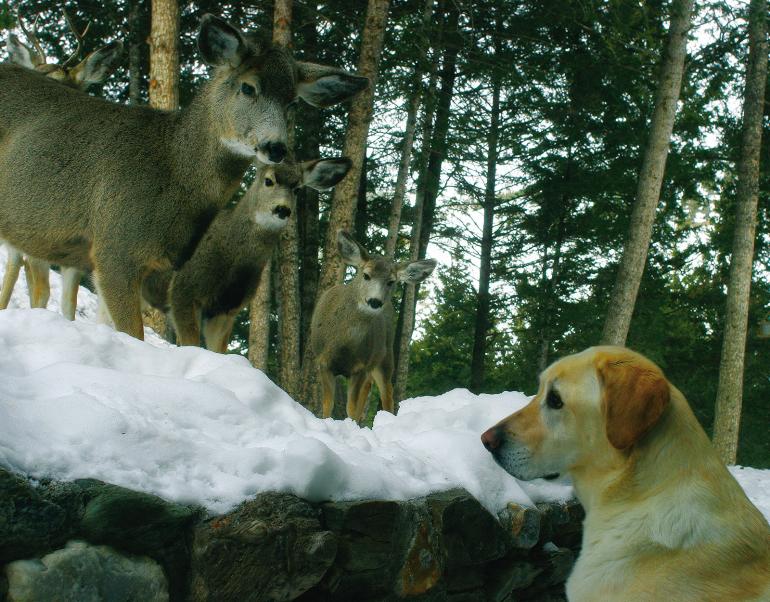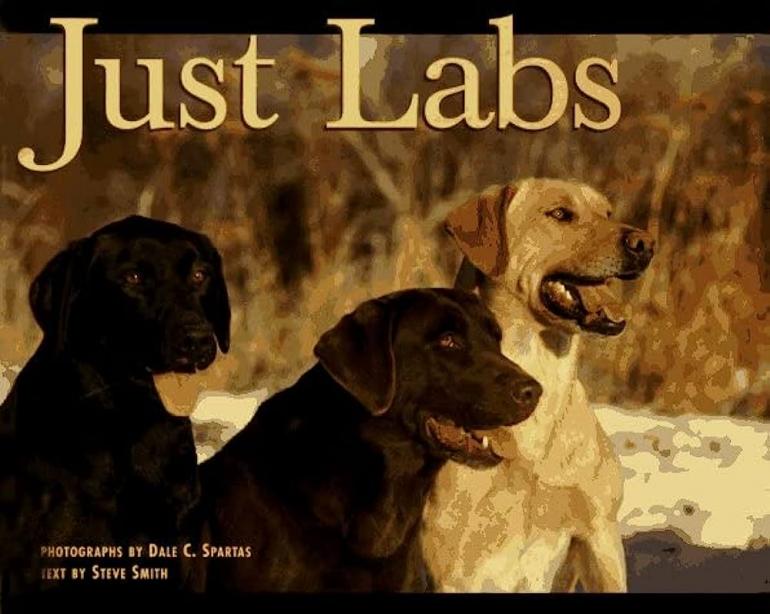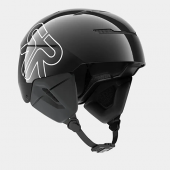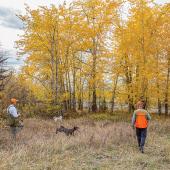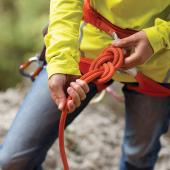A Nose for Nuisance: Safeguard Your Trailhound
My dog is all nose. Black and quivering, it leads him headlong after any whiff of nonsense. Like the day I came down from Mystic Lake. My dog trotted by the creek, snuffling after squirrels but coming when I called. Around a bend we met two riders on horseback. The sun was warm on my face and I was smiling, my dog by my side, my face inches from horse flanks when he sprang, neck outthrust, and poked his curious nose into withers.
I have since learned to control my canine.
Hiking with your dog awards simple pleasures—companionship, security, fitness. But it takes awareness and obedience. You both want to have fun. Basic training and preparation will ensure the safety and comfort of hikers, and the health of your dog and the outdoors.
Discipline
The thing my dog wants most in the world is to hear the words “Good boy,” to feel the warm tickle of fingers behind his ears. Dogs are hardwired for pleasure. To keep yours happy on any jaunt, train him to behave. Know that you can control him in the presence of distractions. Know what situations will provoke flight, aggression, anxiety, or barking, and practice obedience.
Dog Health
Your dog’s condition can make or break a trail day. Tag his collar with a name, phone number, and proof of rabies vaccination. Mosquitoes carry heartworm disease, so update other vaccinations, including fleas and ticks.
Just because you’re itching for a six-mile trek up a ridge doesn’t mean your dog is ready for it. Condition him for distance and terrain. You don’t want to break into that alpine meadow only to have him collapse miles from the trailhead. Dogs are uncomplaining; check them for burrs, ticks, or injury. Paw pads are sensitive and should be tough. Do his nails look like fork tines? Trim them to midlength.
If you’re slicked with sweat and your tongue feels like a rug, consider your dog, who has doubled your mileage on his endless capers. Carry water and a container he will drink from frequently. Bring enough food to refuel him. Dogs over one year can carry up to a third of their weight, but if you strap a pack on your pooch, habituate him first.
Sense and Sensitivity
“He’s friendly, he won’t jump up. Yes I know he’s barking.”
You’re romping with Rover beneath the lodgepoles, but not everyone on the trail is dog-compatible. Carry a leash and use it when required. Hikers may be shouldering a pack or a child or traversing a narrow ledge; many choose a trail for its serenity or the chance to spot wildlife. Communicate with them. Control your dog. Barreling through the bush beyond your view or voice command, your mutt will bring every discovery—Mama bear, poison ivy, a mouthful of rotting fish—back to you. He may not perceive the consequences of cliffs or thin ice. A well-managed dog can sniff and frolic with little inconvenience to either of you. Out of safety and courtesy, train him to stay hushed and behaved in the backcountry.
Doggy doo? Unless it’s well off the trail, do pack it out. Waste fouls the forest and does little good smeared across a boot sole.
Come Swell or High Water
Fat floats. My dog is a mass of muscle: A chest like a barrel, a waist the width of my thigh. Haunches Lance Armstrong would kill for. My dog sinks. Beyond the frantic kerplunk of his front paws all I see are the whites of his eyes.
Know your dog’s swimming abilities before he takes a dip. Even a dog who loves to swim can tire, cramp, or panic, but will paddle until you tell him otherwise. He wants to please; if you throw it, he will follow. Dogs have no sense of swiftwater risks, especially as the snowpack melts. Be aware of waterways swollen with runoff. On big rivers, train your dog to enter only with permission, and watch for obstacles that impede his ability to climb out. On creek crossings, remove all packs, accompany your dog across, and make him stay before you return and recross with the gear.
Animal Alert
We share our trails with critters—bears, mountain lions, moose, rattlesnakes, livestock. Never allow your dog to disturb wildlife. Should you chance upon a beast, maintain control. Your dog may instinctively protect you; keep him quiet and close.
When passing horses, communicate with their riders. Manage your dog. Move off the trail, position yourself between horse and dog, and allow the horse to pass on the uphill side. Release your mutt only when you are confident he will not pursue.
We get out with our dogs because it’s fun. A happy dog is an obedient dog, which takes patience and praise. Because a dog will follow his nose.
Top 10 Doggy Doo-Doo Pick-Up Tips
1. Always do an 8:00 am poop scoop. Frozen is better.
2. Buy better-quality dog food. It actually can produce less waste because of better ingredients.
3. Use rubber gloves and a dust mask. Sometimes luxuries like these make it a little easier.
4. Make a dookie compost patch. In a sunny corner of your fenced yard, till a 4x4 garden plot. Sprinkle every spring with a packet of wildflower seeds and use it to bury and compost your pet waste throughout the year.
5. Get yourself a five-gallon bucket with holes drilled in the lid. This helps during frozen months when digging isn’t possible. Line it like a trash can and after the yard is de-bombed, double bag it for trash collection. Never dump live ammo directly into a trash receptacle. That’s just rude.
6. Pick up doo-doo before you mow. Haste makes waste… on your mower wheels and sneaker soles.
7. Reuse your plastic grocery bags. There is a reason you obsessively save every one of those things. They are perfect for those before- and after-work walks around the neighborhood. If you are courteous about pooch-poo, others will be too.
8. Use Bozeman’s inner-city hiking trail poop sacks. Big thanks to the Land Trust for the donation of the doggy stations. They are everywhere and always well stocked.
9. Practice the stick and flick. Use this technique in wilderness and national forest hiking trails when your pooch leaves a little package on the trail. The dog really doesn’t know any better, but you do.
10. Make a weekly schedule and stick to it. Your pet really does appreciate your clean-up efforts. There are backyard clean-up companies that are happy to help if you can’t keep up with the responsibilities of having a dog as part of your family.
-Beth O'Neill
Just Labs
Photographs by Dale C. Spartas
Text by Steve Smith
Minocqua, WI
Willow Creek Press, 1995
144 pages
If the city of Bozeman had a four-legged mascot, the only question would be whether the canine was black, chocolate, or yellow. Bozeman’s tail is wagging with numerous Labradors of all ages, stages, shapes, and sizes, many of whom have served as A-list models for locally renowned photographer Dale Spartas in his popular book, Just Labs. Just Labs is not a read for those in search of a “how to” formula on raising and training a new Labrador for field or family; rather, it is a beautifully photographed tribute to the breed in which “the real charm is found in the dogs themselves.” The book is a compilation of 17 years of photography and won the Benjamin Franklin award for Best Photographic Book when it was published.
Accompanied by the sparse but insightful prose of outdoor writer and editor Steve Smith, Just Labs captures these game, loyal, and comical canines in all phases of their spirited life. Spartas and Smith’s work portrays the lab as not only an esteemed hunting dog but also a beloved and faithful canine companion for all who are lucky enough to share their lives with the breed. The end result is a treasure that is fondly flipped through again and again. If this sounds appealing to you, then retrieve a copy of Just Labs for yourself or a friend. Autographed and inscribed copies are available directly from Dale at 585-2244 or www.spartasphoto.com. Now that’s sure to fetch a smile.
-Jimmy Lewis

